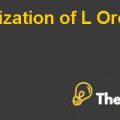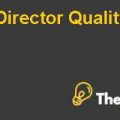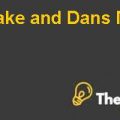
HEDGING NUMERICALS Case Solution
Question 1
a).
A long position would be taken to hedge the plant’s wheat purchase. This is because by taking along futures position, the company would be able to lock ina futures price for the underlying which would be required in June. The company, can therefore, save itself from the risk from the rise of the underlying.
b).
The price which we expect to pay for the June wheat purchases if the company has hedged would be $ 7.75 ($ 8 - $ 0.25).
c).
The future basis would be:
F2 – S2 = 9.5 - 9 = $ 0.5 per bushel
The realized futures price would be:
F1 + Future basis: 8 + (0.5) = $ 8.5 per bushel
d).
The realized hedging price is not equal to the quoted price because of basis risk movements.
e).
The basis risk has increased from $ -0.25 to $ 0.5 in June.We say the basis has weakened.
Question 2
a).
Since we are concerned with the declining prices, therefore, a short position will be taken in the futures market.
b).
The expected hedge price would be : $12.50 - $ 0.25 = $ 12.25 per bushel
c).
The future basis would be:
S2 – F2 = 11.5-12 = -$ 0.5 per bushel
The realized futures price would be:
F1 + Future basis: 12.5 + (-0.5) = $ 12
d)
Yes, the expected hedge price is equal to the realized hedge price. This is called as a perfect hedge.
Question 3
a).
Since we are concerned with the declining prices, therefore, a short position will be taken in the futures market.
b).
The expected hedge price would be : $12.50 - $ 0.25 = $ 12.25 per bushel
c).
The future basis would be:
S2 – F2 = 13.5-14 = -$ 0.5 per bushel
The realized futures price would be:
F1 + Future basis: 12.5 + (-0.5) = $ 12
d)
Yes the expected hedge price is equal to the realized hedge price. This is called as a perfect hedge.
Question 4
a).
A long position would be taken by the company in order to hedge the June copper purchases. The reason is the risk of the rise in the price of copper which is the largest material input used by the company.
b).
The number of the futures contract needed to fully hedge would be: 100000/25000 = 4 contracts.
c).
The expected hedging price would be: $ 3.85 - $ 0.2 = $ 3.65
d).
The future basis would be:
F2 – S2 = 4.15 - 4 = $ 0.15 per pound
The realized futures price would be:
F1 + Future basis: 3.85 + (0.15) = $ 4 per pound
e).
The actual futures price is not equal to the price quoted to the plant manager due to higher basis risk.
f).
The basis risk has Increased from -$0.2 to $ 0.15 per pound. We say the basis has weakened.
Question 5
a).
A short position would be taken in the futures market to hedge the risk of the decline in the precious metal prices.
b).
The number of contracts required to fully hedge the mine’s production would be:
10000/5000 = 2 contracts.
c).
The expected futures price would be: $ 13.50 + 0.75 = $ 14.25 per ounce.
d).
The future basis would be:
S2 – F2 = 11 – 12 = -$ 1 per ounce
The realized futures price would be:
F1 + Future basis: 13.50 + (-1) = $ 12.50 per ounce................
This is just a sample partial case solution. Please place the order on the website to order your own originally done case solution.










